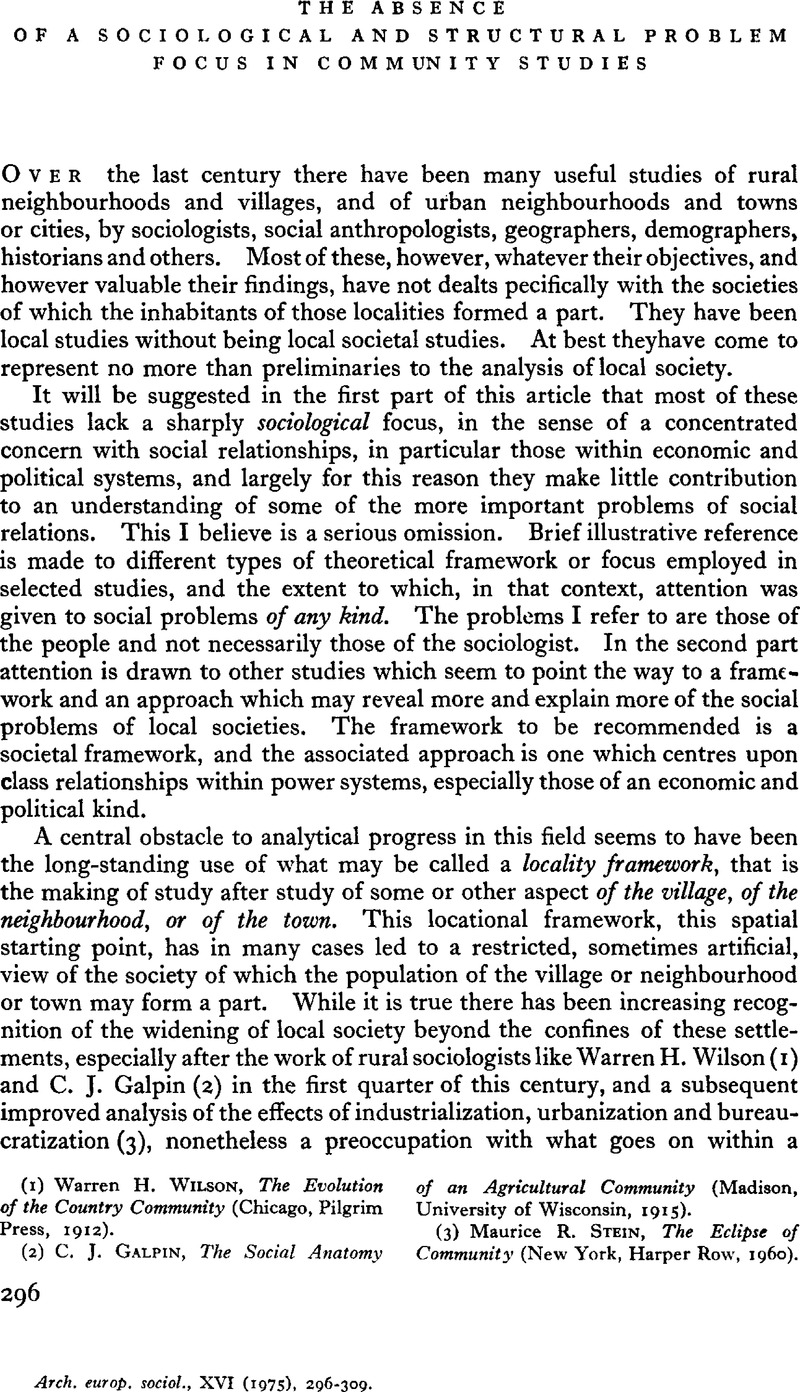Published online by Cambridge University Press: 28 July 2009

(1) Wilson, Warren H., The Evolution of the Country Community (Chicago, Pilgrim Press, 1912).Google Scholar
(2) Galpin, C. J., The Social Anatomy of an Agricultural Community (Madison, University of Wisconsin, 1915).Google Scholar
(3) Stein, Maurice R., The Eclipse of Community (New York, Harper Row, 1960).Google Scholar
(4) In cases where sociologists have looked at outside links, a geographic rather than a sociological emphasis has often been preserved. Attention shifts to the relationships between towns and villages, or between organizations like industrial firms, banks, newspaper companies, schools, hospitals, etc, and their service areas. This may help greatly in the identification or location of a local societybut it does not usually take the analysis of that society or of those organizations and their social fields very far. See Bracey, H. E., Social Provision in Rural Wiltshire (London, Methuen, 1952).Google Scholar
(5) Life and Labour of the People of London 1889–1903. See especially vols I–IV of third edition (17 vols) (London, Macmillan, 1902–1903).
(6) , R. S. and Lynd, H. M., Middletown: a study in contemporary American culture (New York, Harcourt, Brace, 1929)Google Scholar, and Middletwon in Transition: a study in cultural conflicts (New York, Harcourt, Brace, 1937).Google Scholar
(7) Vide 1949 preface to MacIveb, R. M. and Page's, C. H.Society (London, Macmillan, 1949).Google Scholar
(8) Among possible exceptions is Frankenberg's, RonaldVillage on the Border (London, Cohen and West, 1957)Google Scholar. For a study which gives useful comparisons in a wider context see Bell, Colin and Newby, Howard, Community Studies (London, George Allen and Unwjn, 1971)Google Scholar.
(9) See, for example, Rees, Alwyn D., Life in a Welsh Countryside (Cardiff, University of Wales Press, 1950)Google Scholar, chapter xiv, and the conclusion of Williams', W. M.The Sociology of an English Village: Gosforth (London, Routledge and Kegan Paul, 1956)Google Scholar.
(10) A. R. Radcliffe-Brown's holistic approach to the disintegration of tribal societies is a case in point. See Applied Anthropology (Brisbane, Australian and New Zealand Association for the Advancement of Science (1930), pp. 267–280Google Scholar. —His focus is what is relevant here, not his structural analysis which is fully acknowledged. See his Structure and Function in Primitive Society (London, Cohen and West, 1952)Google Scholar. I hope to do justice to his contribution in another paper.
(11) Vidich, Arthur J. and Bensman, Joseph, Small Town in Mass Society (Princeton, Princeton University Press, 1968), p. xviiiGoogle Scholar.
(12) Stacey, Margaret, Tradition and Change: a study of Banbury (London, Routledge, 1960).Google Scholar The restudy of Banbury, by Stacey, Margaret et al. , Power, Persistence and Change (London, Routledge, 1975)Google Scholar appeared after completion of this paper. However, this book, like the earlier article, The Myth of Community Studies, British Journal of Sociology, XX (1969), 134–147Google Scholar, does not appear to affect the argument which follows.
(13) Outside the town in the district, there were in addition two further ‘groups’ which Stacey called the traditional and non–traditional upper classes. Op. cit. p. 173.
(14) Op. cit. p. vi.
(15) Cf. Peter, Blau, M., and Scott, W. Richard, Formal Organizations (London, Routledge and Kegan Paul, 1963)Google Scholar, chapter 11, for a different typology.
(16) Tradition and Change, appendix 4. In a personal communication, Margaret Stacey has explained why she took voluntary bodies as the main indicator of social relations: they represented voluntary unions which underlined the major fractures of the social structure like those between bosses and workers, and they revealed the degree of reinforcement of leadership roles.
(17) Ibid. and p. 82.
(18) Op. cit. p. 173.
(19) Ibid. and p. 148.
(20) In a personal communication, Margaret Stacey has stressed the importance of the “occupational status frontier” representing a major fracture between the working and middle classes.
(21) Op. cit. chapter VIII.
(22) Op. cit. p. 168
(23) Op. cit. p. 37.
(24) In a personal communication, Margaret Stacey has stated that what she had tried to say was that there was not a total structure of Banbury society, but there was a traditional social structure and, then, fragments of others''.
(25) Warren, Roland L., The Community in America (Chicago, Rand McNally, 1963)Google Scholar; 1965 introductionto paperback edition of Studying your Community (New York, The Free Press, 1955)Google Scholar, and Truth, Love and Social Change (Chicago, Rand McNally, 1955)Google Scholar.
(26) Truth, Love and Social Change, p. 291.
(27) The Community in America, p. vii.
(28) Studying your Community, p. vi.
(29) The Community in America, p. 9.
(30) Op. cit. p. 239.
(31) Op. cit. p. 9.
(32) Op. cit. pp. 46, 153 and 208.
(33) Op. cit. p. 161.
(34) Op. cit. chapter VI.
(35) Something of the more detailed type of approach advocated is touched upon by John Rex in his treatment of “housing classes”, e.g. lodging–house proprietors and tenants, in his study of housing policy and race relations in Birmingham. Rex, John and Moore, Robert, Race, Community and Conflict(London, Oxford U.P., 1967)Google Scholar. Arelated view of classes but of classes within associations rather than within wider social systems has been presented in Dahrendorf's, RalfClass and Class Conflict in an Industrial Society (London, Routledge and Kegan Paul, 1959)Google Scholar.